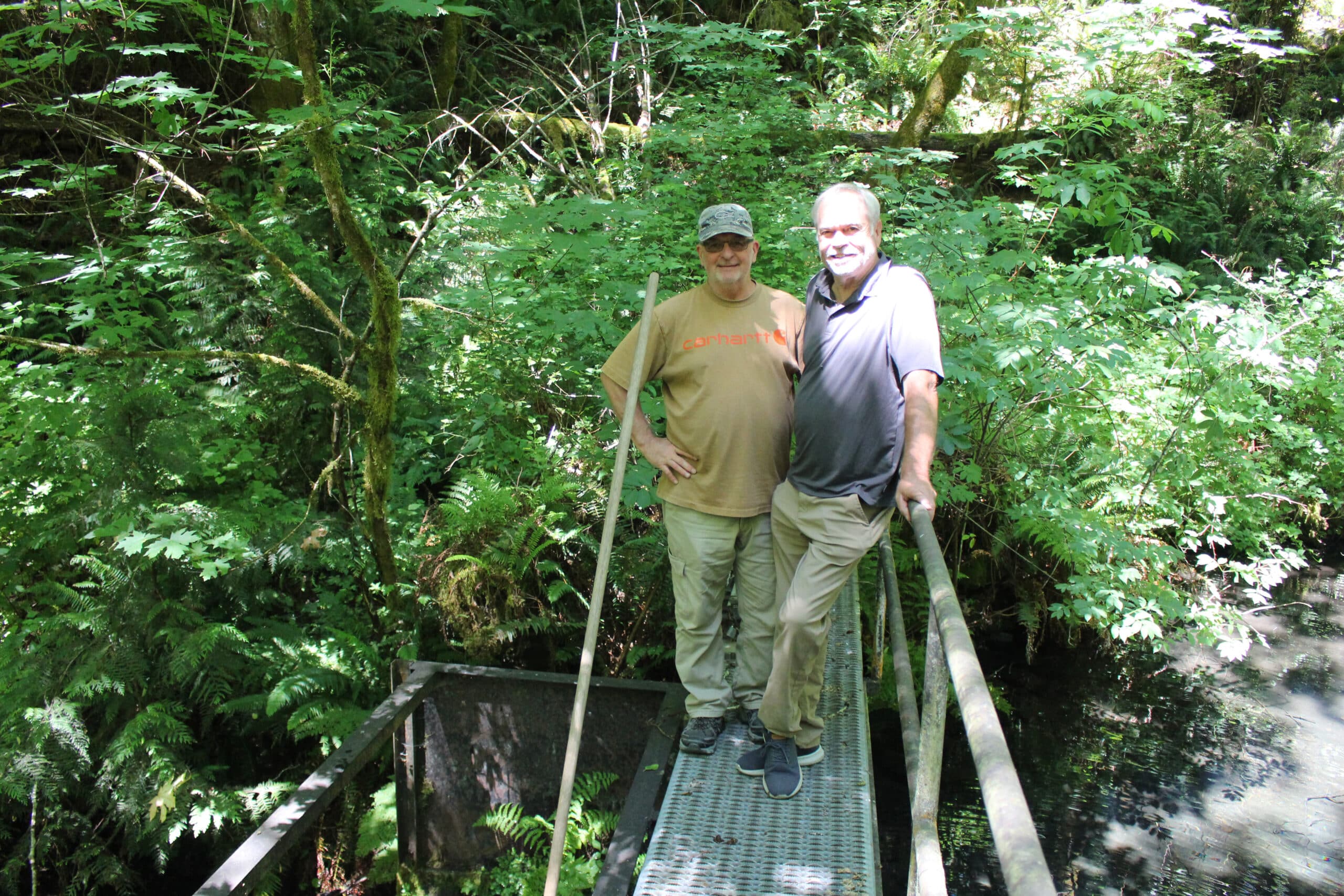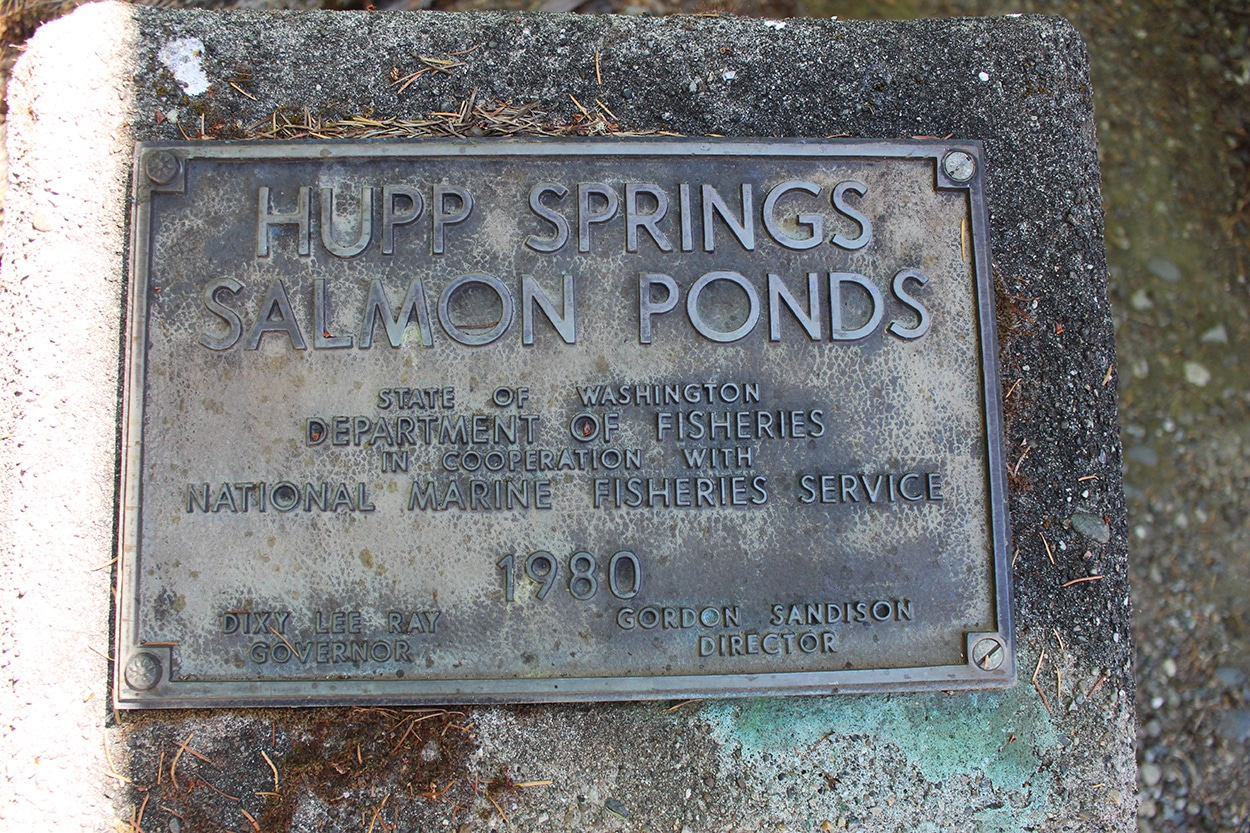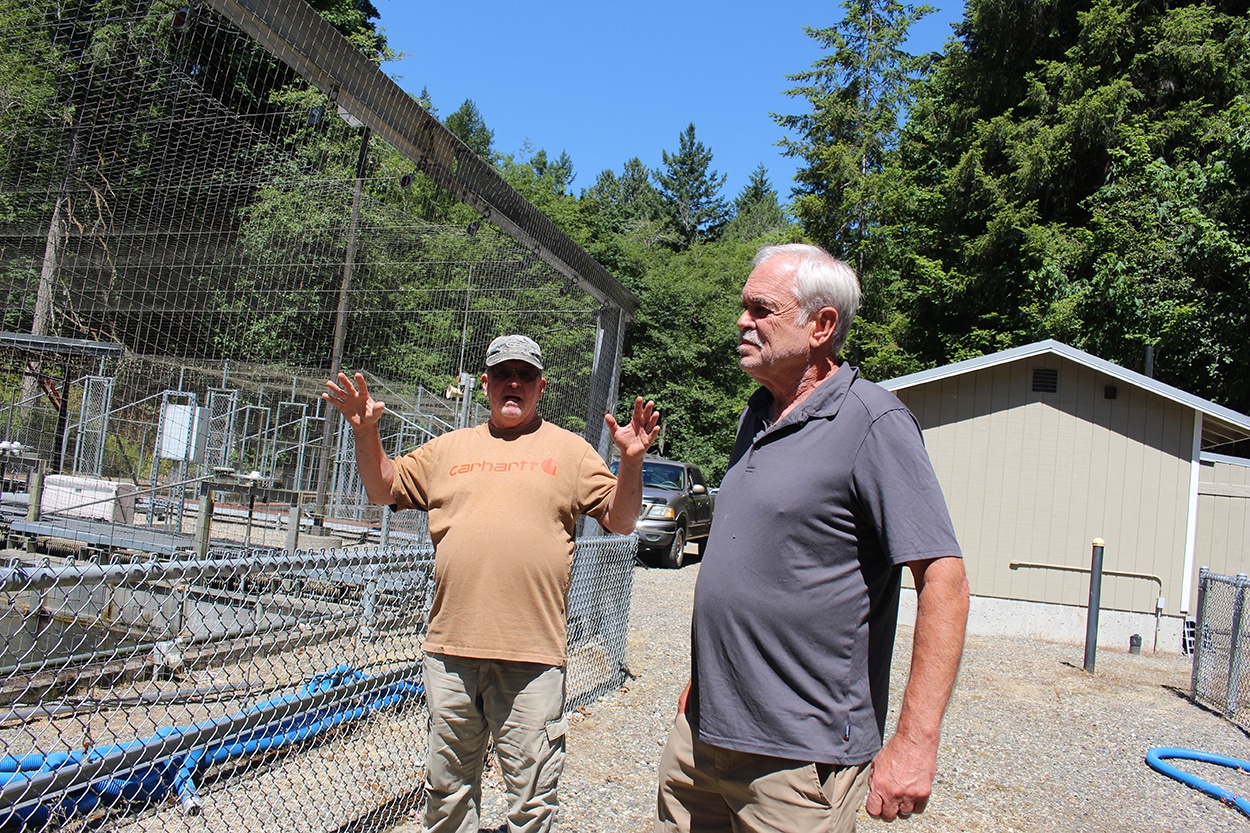Community Environment
In the Margins: Hupp Springs hatchery contributed to a salmon success story
In my previous life, I had the joy of serving as sports editor for The Peninsula Gateway from 1984-93. Many hot dogs and bags of popcorn ago, I had a front-row seat for all things in the Wide, Wide World of Sports here in the Peninsula area. It was a great gig: Taking the pictures, writing the descriptions and chronicling the accounts of all things that ran, bounced or swam in our community.
These days, my curiosity gets the better of me and I wonder what became of so many stories I had the good fortune to write about and learn from. Four decades later, it’s fun to follow up, check back and scratch that incessant itch of curiosity.
For instance … what became of the White River spring Chinook recovery project at the Hupp Springs Salmon Hatchery near Minter Creek? Earlier this summer, I found out. I’m glad I did. It worked out really well for salmon. And that’s good for every other creature that runs, bounces or swims.

Scott Meechan, left, and Larry Peck stand on a footbridge over Hupp Springs, the water source for the Hupp Springs Salmon Hatchery near Minter. Photo by Leland Smith
Hupp Springs Hatchery
Introducing the now-thriving White River run of spring Chinook salmon and the Hupp Springs Salmon Hatchery on the Key Peninsula.
To say the least, the White River spring Chinook were on the ropes four decades back. Larry Peck recalls a time in 1981 when only six and a half remaining White River spring Chinook adult female salmon were collected at the White River. Yes, you read that right: Six and a half. Peck explains:
“The first egg take was at the Mud Mountain Dam (near Buckley) and one of the females was half spawned-out when we caught it in the trap. We started with less that 30,000 eggs.”
This past spring and summer, 830 adult spring Chinook, along with 213 Jack salmon (precocious, smaller males who return to fresh water spawning streams a year early) returned to the Minter Creek salmon hatchery, which collects these adult fish.
In past years, returning adult salmon numbers have consistently broken the 1,000 mark at Minter. The 2023 returning class was a little light, but that’s to be expected in salmon culture which can ebb and flood like the tides.
Meanwhile, returning stocks to the White River have become consistently abundant. Since 2016, the White River has seen as many as 16,000 adult White River springers return. Puyallup and Muckelshoot tribal members have participated in ceremonial fisheries — about 500 salmon harvested — with salmon distributed primarily to tribal elders.
Cue Col. Hannibal Smith: “I love it when a plan comes together.” (That’s an “A-Team” reference, kids, a popular TV show when the White River springer plan was hatched).
Hupp Springs project gets an A
The plan came together. Introducing the Hupp Springs Salmon Rearing Facility … the little hatchery that could, and did.
Peck, who has seen it all and done it all in salmon culture, says if he had to give the Hupp Springs project a grade, it would get a solid A.
As the crow flies, the Hupp Springs hatchery sits about one mile north of the historic Minter Creek Hatchery on Creviston Drive NW, just on the west side of the Purdy Bridge. Surrounded by thick woods and native plants, Hupp Spring bubbles out of the earth providing consistent clear and cold water (48 to 54 degrees) used to incubate salmon eggs. Salmon fry (tiny guys) remain at Hupp thriving in the clear cold water until they can be released into Minter Creek and onward to the world.
“There are three things you need for salmon,” said Peck. “Water, water and water.”
The water at Hupp Springs is nearly perfect for raising salmon. Opened in 1980 (Gov. Dixie Lee Ray and Fisheries Director Gordon Sandison were on hand), think of Hupp Springs as a surrogate mother stream, a protected egg-bank for the White River springers.
The glacial-fed White River is a tributary of the Puyallup River. The White River has historically fostered spring Chinook making the furthest voyage south in Puget Sound. While White River spring Chinook have been successfully restored to their home waters, the Hupp Springs program remains intact as a backup.
Peck (more on him later) is quick to spread the accolades for the project to revive White River springers. Peck says the program served the state and tribes extraordinarily well and serves as a great example of what co-management is supposed to look like. Federal, state and tribal hands (too many to mention individually) worked together and a unique run of salmon was saved.

The on-site plaque for the Hupp Springs Hatchery, opened in 1980. Photo by Leland Smith
Spring Chinook
Tell it, Larry:
“Washington Department of Fish and Wildlife (WDFW) and the Squaxin Island Tribe initiated the White River Spring Chinook Captive Brood Program, where we transferred Spring Chinook smolts from Hupp Springs to the Squaxin Island Net Pen Complex where these smolts were reared until they reached sexual maturity. These fish would reach sexual maturity between the ages of 3 and 5 years old. This was the state’s first effort of this type and proved to be very successful in securing eggs to increase releases at Hupp Springs and begin a ‘supplementation program’ back into the White River.”
Unique? Muckleshoot and Puyallup Tribal members have been able to revive and enjoy Ceremonial First Fish Celebrations thanks in part to this program. Spring Chinook salmon, the first to arrive each year in the annual spawning cycle, are highly revered.
They are highly revered by endangered orcas. To the Southern Resident Orca, spring Chinook salmon are the staple of their food source … the biggest section in an Orca’s aquatic grocery story, with shrinking inventory and minimal open hours.
They are highly revered by sports anglers. They’re first on the scene every year. They run like Jesse Owens and fight like Muhammad Ali (Float like a butterfly, sting like a bee).
They are highly revered by hungry two-legged predators for their high fat content, crimson flesh and inspiring fresh flavor. Eat one. You’ll get it. Nuff said.
Bold project met resistance
In the late 1980s, bold steps were taken to protect returning adult salmon to the Minter and Hupp facilities. It was not popular among salmon anglers. For several years, much of Henderson Bay, north of Fox Island, was entirely closed to all fishing for most of the spring and early summer.
I recall frequent chats with Minter Creek hatchery managers Paul Pedersen and Denis Popachock, along with Hupp Springs manager Rich Eltrich (thank you guys for being so open and honest with this idiot reporter years ago). Joe Public would rip them. But like the White River springers, they endured.
“I told people we’d have fish back in the White River in my lifetime,” said Peck, a fisheries lifer and Olympia resident.“In 1982, I thought it would take 20 years or four complete brood stocks (a Chinook salmon’s lifespan is about five years). This hatchery (Hupp) has done extremely well.”
Forecasting returning salmon runs while protecting endangered stocks in high-visibility locations is not for the weak at heart.
Introducing Larry Peck
“Working with salmon is like an onion,” said Peck, 70. “The more layers you peel back, the more it can make you cry. When you think you’ve got things figured out, you better quit. There are so dang many variables. My favorite saying to fishermen is that we are really good at predicting what happened last year.”
A native of Ballard, where he grew up around all things fishing, Peck has chased salmon his entire professional career. His path started as a grunt fisheries culturist on the Elochoman River in southwest Washington. He eventually worked up to serve as interim agency director from 1997-98. Though he retired in 2007, he keeps his head in the game as an advisor for hatchery design.
Peck knows every rock and pebble in the salmon-spawning process. Mention a river in our state and he’ll tell you the name of the hatchery on that river, the year that hatchery came on line, it’s very first and current manager.
“I knew what I wanted to do after my sophomore year in college. When I read ‘The Salmon: Their Fight for Survival’ by Anthony Netboy, I knew I wanted to work with salmon,” said Peck.

Scott Meechan, left, discusses hatchery issues with Larry Peck at the Hupp Springs Salmon Hatchery near Minter. Meechan oversees daily operation at Hupp Springs. Photo by Leland Smith
Football and fish
Peck attended Whitworth College in Spokane, playing football for legendary coach Hugh Campbell, one-time WSU star receiver who did nothing but win as a player with the Saskatchewan Roughriders and later as a coach and general manager for the Edmonton Eskimos. Peck played “monster-back,” a hybrid linebacker/strong safety.
It was the early 1970s and Peck wore a neckroll, led the team in tackles and probably complained when they wouldn’t let him play on point-after attempts. Throughout college, he’d routinely pick up the phone and pester Fisheries Department Director Don Moos, telling him he wanted to work with fish. Upon graduation, Peck finally wore Moos down.
“I called up Moos and said it was Larry Peck and I was still looking for a job,” Peck remembers. “He said ‘Can you be at the Elochoman hatchery tomorrow at eight o’clock?’ I said ‘Yes, sir.” He said ‘Any questions?’ I said ‘Yes. Where is it?”
On the spot, Campbell sold Peck his own mom’s 1968 Buick Skylark (light green, two doors, 327 cubic inches, four-barrel carbs). Peck packed, drove all night to the hatchery near Cathlamet and slept in the parking lot.
“In the morning I met Bernie Cossette (hatchery manager) and he said ‘who are you? I said ‘I’m Larry Peck. I just graduated from Whitworth College and I’m here to work for you.’ He said a couple of cuss words and asked if I was one of those college kids who thinks he knows everything. I said ‘With all due respect, when it comes to salmon, I know nothing. I’m glad I have someone to teach me.’ ”
It worked.
Change is a constant
Peck became a revered hatchery specialist, mentor and driving force behind our state’s network of salmon hatcheries. If he says the Hupp Springs project is worthy of an “A,” it gets an A.
In the meantime, the changes and alterations he’s witnessed with salmon and hatcheries could fill six careers. Think about this: Peck remembers when Seattle’s tallest building was the Smith Tower … by a long shot. It’s now the little guy on the landscape.
There was no I-5 through Seattle. The city of Covington “was a gas station” that now has over 1,400 wells sipping up precious groundwater. Our state’s population has grown from 3 million in 1965 to 7.7 million. Cool, spring groundwater resources are drying up at alarming levels. By 2050, scientists predict, glaciers will no longer exist in the pristine Olympic Mountains. Meanwhile, starving orcas, foodies, and every creature in-between craves salmon. There’s not enough to satisfy everyone’s appetite.
Salmon rearing processes that worked in the 1970s no longer work. The name of the game is change.
“So you’ve got to find that sweet spot,” Peck says about mankind’s custodial role with salmon. “And when you find that sweet spot, there’s no guarantee it’s gonna work next year. It’s frustrating, but that’s what makes salmon such a fascinating critter. I guess that’s why they have such a fascinating place in my heart.”
